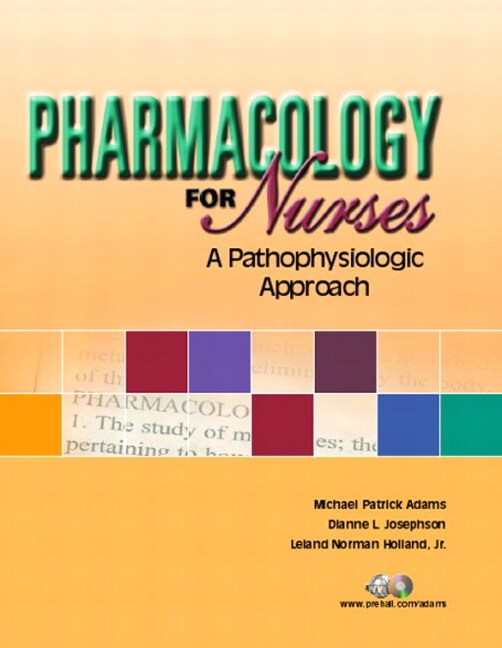Table of Contents
I. CORE CONCEPTS IN PHARMACOLOGY.
1. Introduction to Pharmacology: Drug Regulation and Approval.
2. Drug Classes and Schedules.
3. Emergency Preparedness.
4.. Principles of Drug Administration.
5. Pharmacokinetics.
6. Pharmacodynamics.
II. PHARMACOLOGY AND THE NURSE-PATIENT RELATIONSHIP.
7. Drug Administration throughout the Lifespan.
8. The Nursing Process in Pharmacology.
9. Legal and Ethical Issues Related to Drug Administration.
10. Holistic Pharmacotherapy: Psychosocial, Cultural, Environmental, Genetic, and Gender Considerations.
11. Herbal and Alternative Therapies.
12. Substance Abuse.
III. THE NERVOUS SYSTEM.
13. Drugs Affecting the Autonomic Nervous System.
14. Drugs for Anxiety and Insomnia.
15. Drugs for Seizures.
16. Drugs for Emotional and Mood Disorders.
17. Drugs for Psychoses.
18. Drugs for Degenerative Diseases of the Central Nervous System.
19. Drugs for the Control of Pain.
20. Drugs for Local and General Anesthesia.
IV. THE CARDIOVASCULAR AND RESPIRATORY SYSTEMS.
21. Drugs for Hypertension.
22. Drugs for Heart Failure.
23. Drugs for Dysrhythmias.
24. Drugs for Coagulation Disorders.
25. Drugs for Angina Pectoris, Myocardial Infarction, and Cerebrovascular Accident.
26. Drugs for Shock.
27. Drugs for Lipid Disorders.
28. Drugs for Hematopoietic Disorders.
29. Drugs for Pulmonary Disorders.
V. THE IMMUNE SYSTEM.
30. Drugs for Immune System Modulation.
31. Drugs for Inflammation and Allergies.
32. Drugs for Bacterial Infections.
33. Drugs for Fungal, Protozoal, and Helminth Infections.
34. Drugs for Viral Infections.
35. Antineoplastic Drugs.
VI. THE GASTROINTESTINAL SYSTEM.
36. Drugs for Peptic Ulcer Disease.
37. Drugs for Bowel Disorders, Nausea, and Vomiting.
38. Agents that Nutritional Disorders.
VII. THE ENDOCRINE AND GENITOURINARY SYSTEMS.
39. Drugs for Pituitary, Thyroid, and Adrenal Disorders.
40. Drugs for Pancreatic Disorders.
41. Drugs for Disorders and Conditions of the Female Reproductive System.
42. Drugs for Disorders and Conditions of the Male Reproductive System.
43. Drugs for Renal Disorders and Diuretic Therapy.
44. Drugs for Fluids, Electrolyte, and Acid-Base Disorders.
VIII. THE INTEGUMENTARY SYSTEM, MUSCULOSKELETAL SYSTEM, AND EYES/EARS.
45. Drugs for Muscle Spasms and Spasticity.
46. Drugs for Bone and Joint Disorders.
47. Drugs for Skin Disorders.
48. Drugs for Eye and Ear Disorders.
Glossary.
Appendix A: Canadian Drugs and their U.S. Equivalents.
Appendix B: Drugs Most Frequently Encountered by Nurses.
Appendix C: Bibliography and References.
Appendix D: Answers to Critical Thinking Questions.
INDEX with Diseases.


0 commentaires:
Enregistrer un commentaire